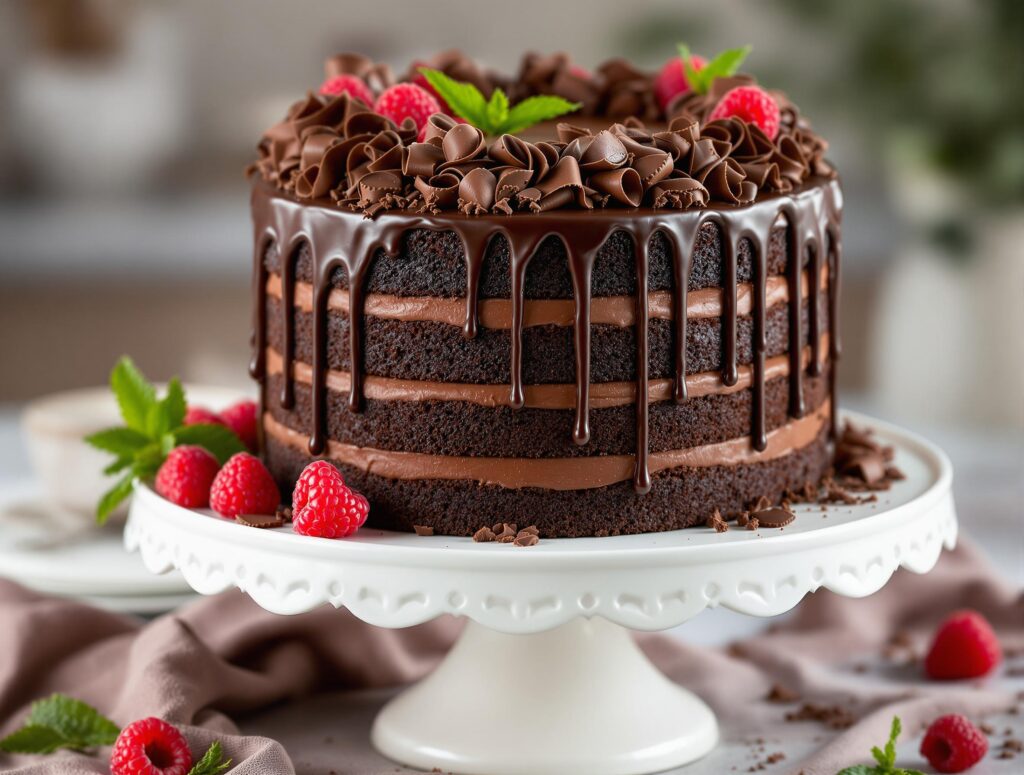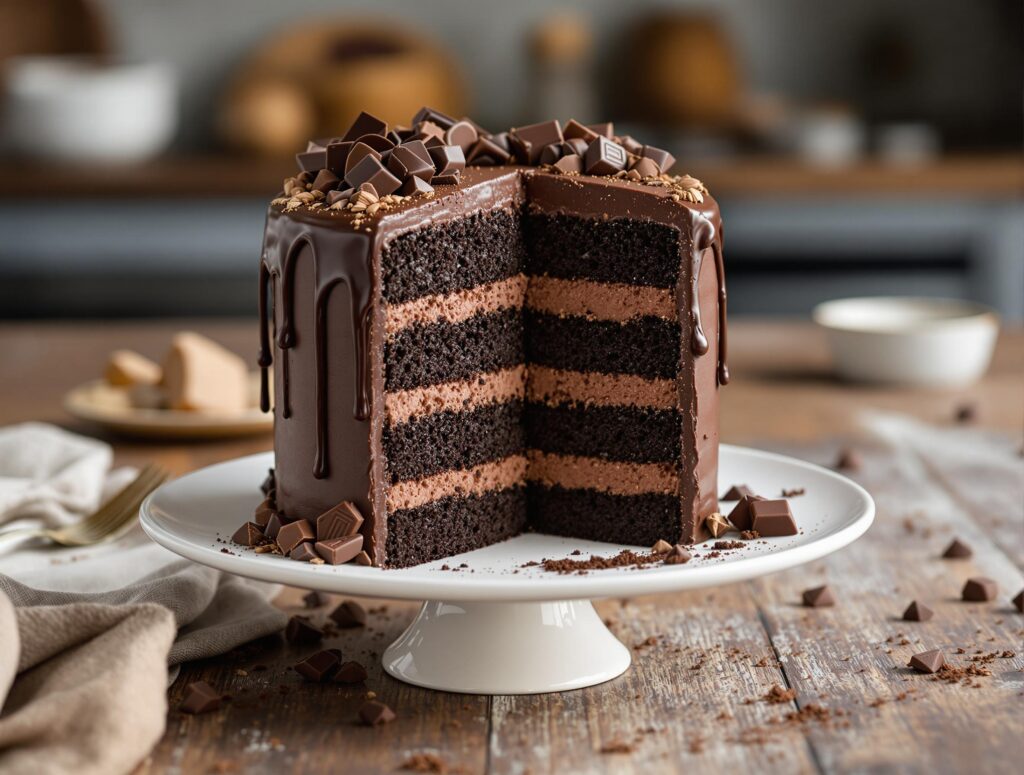Who doesn’t love a rich, moist, and decadent chocolate cake? The Extreme Chocolate Cake takes this indulgence to the next level, boasting layers of deep, dark chocolate flavors that satisfy even the most demanding sweet tooth. Whether you’re a seasoned baker or someone taking their first dive into the world of desserts, mastering the art of an extreme chocolate cake can transform your baking game.
Table of Contents
What Makes an Extreme Chocolate Cake Unique?
An extreme chocolate cake is more than just a dessert; it’s a celebration of chocolate. The secret lies in its intensity: layers of moist cake infused with chocolatey goodness and paired with rich frosting, creating a dessert that feels indulgent yet balanced.
Features of an Extreme Chocolate Cake:
- High cocoa content: Both in the cake and frosting, premium cocoa delivers unparalleled flavor.
- Moist texture: Achieved through precise ingredient ratios.
- Sophisticated presentation: Often adorned with toppings like ganache, berries, or chocolate curls.
The result? A cake that embodies the ultimate chocolate experience.
Key Ingredients for Extreme Chocolate Cake

Selecting the Right Cocoa Powder
Cocoa powder is the backbone of any chocolate cake. Opt for Dutch-processed cocoa powder for a darker color and richer flavor. This type has a smoother taste compared to natural cocoa powder, which tends to be more acidic.
- Dutch-processed cocoa: Best for its mellow flavor profile.
- Natural cocoa: Works well if you enjoy a slightly tangy aftertaste.
Role of High-Quality Chocolate
The chocolate you use defines the cake. Invest in premium dark chocolate with at least 70% cocoa solids. This adds depth to the flavor without being overly sweet.
Step-by-Step Guide to Making Extreme Chocolate Cake
Creating the perfect extreme chocolate cake is a rewarding process that blends precision and creativity. This section provides a detailed, step-by-step guide to help you craft a moist, rich chocolate cake with the ultimate wow factor.
ent a dense cake. Mix just until the batter is smooth and free of streaks.
Ingredients for the Cake
(Serves 10-12)
Dry Ingredients
- 2 cups (250g) all-purpose flour
- 2 cups (400g) granulated sugar
- ¾ cup (75g) unsweetened cocoa powder (use high-quality cocoa for intense flavor)
- 2 teaspoons baking powder
- 1½ teaspoons baking soda
- ½ teaspoon salt
Wet Ingredients
- 1 cup (240ml) whole milk
- ½ cup (120ml) vegetable oil (or melted butter for a richer flavor)
- 2 large eggs (room temperature)
- 2 teaspoons pure vanilla extract
- 1 cup (240ml) boiling water (or hot coffee for extra depth)
Ingredients for Chocolate Frosting
- 1 cup (230g) unsalted butter, softened
- 3½ cups (440g) powdered sugar
- ½ cup (45g) unsweetened cocoa powder
- ½ teaspoon salt
- ½ cup (120ml) heavy cream or milk
- 2 teaspoons vanilla extract
Instructions
Step 1: Prepare the Cake Batter
- Preheat your oven to 350°F (175°C). Grease and flour two 9-inch (23cm) round cake pans or line them with parchment paper.
- In a large mixing bowl, whisk together the flour, sugar, cocoa powder, baking powder, baking soda, and salt.
- Add the milk, oil, eggs, and vanilla extract. Beat with a hand mixer or whisk until smooth and well combined.
- Slowly pour in the boiling water (or hot coffee) while mixing. The batter will be thin – that’s normal!
Step 2: Bake the Cake
- Divide the batter evenly between the prepared cake pans.
- Bake for 30-35 minutes or until a toothpick inserted in the center comes out clean.
- Let the cakes cool in the pans for 10 minutes, then transfer them to a wire rack to cool completely.
Step 3: Make the Chocolate Frosting
- In a large bowl, beat butter until smooth and creamy.
- Gradually add powdered sugar, cocoa powder, and salt, beating well after each addition.
- Pour in heavy cream (or milk) and vanilla extract, then beat until fluffy and spreadable.
Step 4: Assemble the Cake
- Place one cake layer on a serving plate. Spread a generous amount of frosting over the top.
- Place the second cake layer on top and frost the entire cake, covering the sides and top.
- Smooth the frosting with a spatula or create swirls for a decorative touch.
- Optional: Garnish with chocolate shavings, sprinkles, or fresh berries.
Step 5: Serve & Enjoy!
- Let the cake set for about 15-30 minutes before slicing.
- Serve with a scoop of vanilla ice cream or a drizzle of chocolate ganache for extra indulgence!
Tips for the Best Extreme Chocolate Cake
- Use high-quality cocoa powder for the best chocolate flavor.
- Don’t overmix the batter, or the cake may become dense.
- Boiling water (or coffee) enhances the chocolate taste and keeps the cake extra moist.
- Chill the cake before slicing for cleaner cuts.
Baking the Cake
The baking stage is where your preparation and mixing efforts come to life.
Checking for Doneness
Bake the cake layers for 25–30 minutes. To test for doneness:
- Insert a toothpick into the center; it should come out clean or with a few moist crumbs.
- Lightly press the top; it should spring back when done.
Cooling the Cake Properly
Allow the cake layers to cool in their pans for 10–15 minutes before transferring them to a wire rack. This prevents them from sticking and ensures they maintain their structure.
Pro tip: Wrap each layer in plastic wrap once cool to retain moisture before frosting.
Crafting the Ultimate Chocolate Frosting
No extreme chocolate cake is complete without an indulgent frosting. Choose from these popular types:
Types of Frosting: Ganache, Buttercream, and Whipped Chocolate
- Ganache: A simple mixture of heavy cream and chocolate, perfect for a glossy finish.
- Buttercream: Sweet and creamy, made with butter, powdered sugar, and melted chocolate.
- Whipped chocolate frosting: Light and airy, ideal for those who prefer less sweetness.
Tips for Smooth Application
- Crumb coat: Apply a thin layer of frosting to seal in crumbs.
- Refrigerate for 15–20 minutes before adding the final layer.
- Use an offset spatula to achieve a smooth finish.
Decorating and Presenting Your Extreme Chocolate Cake
The art of decorating an extreme chocolate cake is where your creativity can truly shine. In this section, we’ll explore techniques for assembling, decorating, and presenting your masterpiece to achieve a professional finish.

Layering the Cake
Leveling Each Layer
A balanced cake starts with even layers. Use a serrated knife or a cake leveler to remove any domed tops from your cake layers.
- Place the layer on a turntable for better control.
- Slice slowly, rotating the turntable as you go, to achieve a flat surface.
Flat layers ensure stability and even distribution of filling and frosting.
Using Filling for Added Flavor
Adding a filling between the layers enhances both flavor and texture. Popular options include:
- Chocolate ganache: For a rich, decadent taste.
- Fruit preserves: Raspberry or cherry pairs wonderfully with chocolate.
- Whipped cream or mousse: Lighter options to balance the richness.
Spread an even layer of filling between each cake layer, leaving a small border to prevent spillage.
Techniques for a Stunning Presentation
Piping and Texturing
Decorating your cake with piping techniques adds elegance and detail. Equip yourself with a piping bag and a selection of tips to create different effects.
- Rosettes: Use a star tip for classic floral designs.
- Borders: Pipe simple patterns like beads or shells around the edges.
- Textured frosting: Smooth or swirl the frosting with an offset spatula for a rustic finish.
Adding Toppings: Fruits, Nuts, and Edible Decorations
Toppings provide a finishing touch and elevate the cake’s visual appeal. Here are some ideas:
- Fresh fruits: Strawberries, raspberries, or sliced oranges for color contrast.
- Chopped nuts: Almonds, hazelnuts, or pecans for added crunch.
- Chocolate accents: Shaved curls, shards, or even truffles for a luxurious touch.
You can also use edible glitter or gold leaf for a truly extravagant look.
Common Mistakes and How to Avoid Them
Baking and decorating a chocolate cake can be challenging, but knowing how to sidestep common pitfalls will save you time and frustration.
Overbaking or Undercooking
- Problem: Overbaking results in a dry cake, while undercooking leaves the center gooey.
- Solution: Check the cake’s doneness with a toothpick and rely on visual cues, like edges pulling away from the pan.
Frosting Failures
- Problem: Frosting that’s too runny or too thick can be difficult to work with.
- Solution: Adjust the consistency by adding powdered sugar (to thicken) or milk/cream (to thin). Always work with room-temperature frosting for better spreadability.
Variations of Extreme Chocolate Cake
Why stop at the classic version when you can experiment with exciting flavors and dietary adaptations?
Gluten-Free Options
Replace traditional flour with gluten-free alternatives like almond flour or a gluten-free baking blend. Ensure that all other ingredients, like cocoa powder and chocolate, are certified gluten-free.
Adding Unique Flavors: Coffee, Chili, or Caramel
- Coffee: Add espresso powder to the batter for a mocha twist.
- Chili: A pinch of cayenne or chili powder adds a subtle kick that enhances the chocolate flavor.
- Caramel: Drizzle caramel sauce between layers or over the top for a sweet, sticky surprise.
Experimenting with these variations keeps your baking exciting and caters to diverse tastes.
More FAQs
- Can I Pair Extreme Chocolate Cake with a Healthy Breakfast Like Cottage Cheese Pancakes?
Absolutely! For a balanced day, consider starting with The Ultimate Guide to Making 3-Ingredient Cottage Cheese Pancakes with No Flour or Oats, and enjoy the chocolate cake as a decadent dessert later. - Can I use milk chocolate instead of dark chocolate?
Dark chocolate is preferred for its robust flavor, but milk chocolate can work if you prefer a milder taste. - How do I prevent my cake from sticking to the pan?
Grease the pan thoroughly with butter or non-stick spray and line it with parchment paper. - What’s the best way to store leftover cake?
Wrap it in plastic wrap and store it in an airtight container at room temperature for up to 3 days or refrigerate for up to a week. - Can I freeze the cake layers?
Yes, wrap each layer tightly in plastic wrap and freeze for up to 3 months. Thaw at room temperature before decorating. - What’s the secret to a shiny ganache topping?
Use high-quality chocolate and heat the cream just enough to melt the chocolate without overheating. - How can I make my cake more moist?
Use ingredients like buttermilk or sour cream and avoid overbaking. - What’s the ideal thickness for cake layers?
Aim for layers that are about 1 inch thick to ensure even stacking and a balanced flavor. - Do I need to refrigerate the frosting before use?
Not always. Room-temperature frosting is easier to work with, but chilling it briefly can help firm up the consistency. - Can I add alcohol to the cake?
Absolutely! Add a splash of liqueur like Baileys, Kahlúa, or Grand Marnier to the batter or frosting for an adult twist.
Conclusion:
Once your extreme chocolate cake is decorated and ready, take a moment to appreciate your hard work. Slice into the cake to reveal its layers of moist, rich goodness, and enjoy the symphony of flavors.
Whether served at a party or enjoyed as a personal indulgence, an extreme chocolate cake is more than a dessert—it’s an experience. Share it with loved ones or savor it solo, knowing you.
